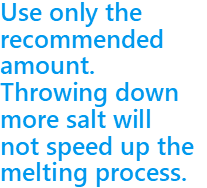Ice & Snow Control
We can have safe walkways in the winter and cleaner water all year round.
Winter in Northeast Wisconsin is a great time for outdoor fun, like ice fishing, ice skating, sledding and skiing. Here, winter also means mountains of snow to shovel and layers of ice to remove from driveways and sidewalks.
We often try to make ice removal easier by using products like salt and sand to melt the snow and ice. Many people do not realize that these products are harming local waters and the animals that rely on them. When the ice and snow melt, the salt and chemicals flow into street drains that lead directly to rivers and lakes.
Shovel Often & Early
Shoveling often during and immediately following the storm removes the snow from walkways and driveways before it gets packed down by tires and feet. The most important part of deicing is removing as much snow as possible before applying salt or sand – it’s also great exercise!
Make the Most of the Salt you Use
It is not always necessary to see bare pavement to have a safe winter surface. Ask yourself if it is necessary that the snow or ice be removed. For salt to be effective, air temperature needs to be warmer than the surface temperature of the area you want to treat. A little goes a long way. Use only the recommended  amount. Throwing down more salt will not speed up the melting process. Use only enough deicer to break the bond between the ice and the pavement, then remove the remaining slush by shoveling.
amount. Throwing down more salt will not speed up the melting process. Use only enough deicer to break the bond between the ice and the pavement, then remove the remaining slush by shoveling.
Limit the Amount of Sand you Use
Sand provides traction. It does not melt ice. Sand, although not chemical, contributes to polluting our local waters. It adds to the excess sediment that is entering waterways, eliminating important habitat for aquatic plants and animals. Sand does play
a role in winter road management. It is often used by municipalities on roads to help maintain traction. Since ice removal is typically the concern of homeowners, sand may not be necessary.
Stormwater is rain or snowmelt and water from things people do, like overwatering the lawn or discharging pool water into the street drain. We can choose products carefully and shape our lawns and pavement so water sinks in. When we do, runoff is reduced, pollutants filter out and streams and groundwater are protected.
Untreated runoff is the biggest threat to our nation’s water quality, according to the U.S. Environmental Protection Agency. Let’s make the small, important changes that will reduce that threat and improve water quality and our lives!
